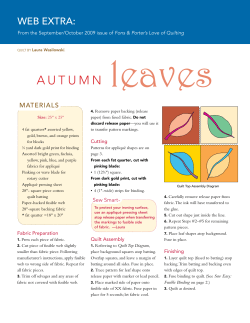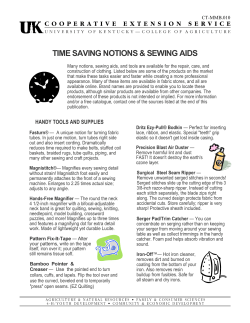
Impressionist Stained Glass Love Letters Supply List
Impressionist Stained Glass Love Letters Supply List Sewing Machine Pins Paper Scissors 9” x 11” Lite Steam-A-Seam Cotton Batting 14” x 16” Fabric Sharpie Ultrafine Marker Sharp Fabric Scissors Rotary Cutting Equipment Safety Pins - or Sulky KK2000 basting spray Prewash all fabrics. Fusible products may not adhere to unwashed fabric!! Black “leading” 9” x 11” Leaves 4 ½" x 6 ½" Center Yellow 2" square Petals 4" x 6" Background 6" x 13" Heart 6" x 8" Border ¼ yard Cut strips of border fabric: 2 strips 2 1/2“ x 8” 2 strips 2 1/2“ x 14” Binding (black) ¼ yard Backing (black) fat quarter Impressionist Stained Glass What is Impressionist Stained Glass? It is an excitingly simple approach to stained glass quilts. If you can trace, cut and press, you can make a beautiful stained glass quilt! Colored pieces of fabric are fused directly to a background of black fabric, the gaps left between the colored fabrics create the stained glass “leading”. When cutting the colored fabric pieces, the original pattern line is interpreted by the individual quilter as the pieces are trimmed and fused to the background fabric, giving the finished design an organic feeling of movement. An added benefit of this approach to stained glass is that the “leading” is approximately 1/8” wide, allowing for greater detail. Bear Paw Productions PO Box 230589 • Anchorage, AK 99523-0589 Phone (907) 349-7873 • FAX (907) 349-7875 www.bearpawproductions.com All Rights Reserved. No part of this information may be reproduced without written permission from the author. Leaf Leaf www.bearpawproductions.com PO Box 230589 • Anchorage, AK 99523-0589 Phone (907) 349-7873 • Fax (907) 349-7875 Bear Paw Productions ©2000 by Brenda Henning Love Letters Heart Background Heart Flower 1 Flower Heart Flower Flower center Flower Leaf Leaf Background Heart Background Impressionist Stained Glass Love Letters Fabric Selection & Preparation When selecting fabric for stained glass quilts I prefer Hoffman Bali Batiks. Hoffman Batiks give the wonderful fluid appearance that I search for when designing stained glass quilts. When searching for the ideal fabric for use in your quilt, please consult your local quilting shop; they are your best source for current fabrics. Pre-wash all fabrics to be used in this project! This removes the sizing that may prevent the fusible web from adhering properly. Spray starch and other fabric finishes should be avoided as they may also reduce the effectiveness of the fusible. Fusible Web Selection Straight lines are drawn using a ruler. Label - Label - Label Label each piece of fusible web to simplify assembly of the design. The fabric and location designators printed on the pattern are most helpful. Cut the fusible web between the drawn lines. This will leave a small margin of fusible web around each piece that will be trimmed away later. Lite Steam-A-Seam from the Warm Company is the fusible web used when constructing this project. Lite Steam-A-Seam is a terrific light weight fusible web that provides a permanent fuse while leaving the fabric soft and supple. The best feature of Lite Steam-A-Seam is the sticky coating on one side that allows for temporary positioning of the applique pieces on the black “leading” fabric. This permits repositioning of the applique pieces when you are ready to permanently press the pieces in place. Fusible Web Place the Lite Steam-A-Seam, paper side up, on the printed side of the pattern. Trace a line on each side of the pattern lines using a Sharpie permanent marker. This will create a grid of lines 1/8” apart. Press the fusible web to the wrong side of the selected design fabrics following manufacturer directions. Cut the fabric just inside the drawn line. This will ensure that your design elements do not grow and encroach on the “leading” lines. This small amount of variation, which will be unique to each quilt, also adds to the organic, artful look of the design. The small amount of excess fusible that is cut away in this step ensures that the fabric edge will not fray. Quilt Top Assembly Cut a piece of black “leading” fabric 9” x 12”. Press. Pin the black fabric, right side up, to the wrong side of the pattern. Because the leading fabric is black, there is no easy way to transfer the pattern to the fabric. The following method is my preferred way to assemble the quilt top. Pin the background fabric to the wrong side of the pattern, pin the layers together to hold them in place. Tape the pinned fabric/pattern unit to a large sunny window. This acts as a large light box, allowing placement of the fabric pieces without the necessity of extensive tracing. Press the fabric pieces in place with a hot iron using a straight up and down motion. Do not move the iron back and forth - this will make the applique pieces slip out of alignment or flip the edge of nearby pieces. The iron must be kept in place long enough to thoroughly melt the fusible web and permanently adhere the two fabric layers. Border Application Trim the fused design to 8” x 10”. Apply the borders to the design block using a 1/4” seam allowance. Press the seams toward the border strips. Layering the Project After applying the border strips, layer the stained glass project with batting and backing. Cotton batting works best. The cotton fibers of the batting grip the quilt top and backing. This helps to prevents shifting and puckering. Rather than outline quilting all of the units as is the customary practice when making a fusible applique quilt, I suggest quilting within each design element. Variegated threads that matched the individual design elements are used on the top and in the bobbin. Peel the back from the fused/cut fabric pieces and finger press in place on the background fabric. If you are using Lite Steam-A-Seam, the fusible exposed when the paper backing is removed will be sticky and the cut fabric piece will stay in place while you are positioning the rest of the cut pieces. If your fusible is something other than Steam-A-Seam, I would recommend lightly tacking the fabric pieces in place with a hot mini-iron. As the fabric pieces are placed, move the pins that would be covered by a fabric piece to a nearby strip of “leading”, this will allow the paper/fabric unit to remain stable without burying a pin. When all fabric pieces have been positioned on the background fabric transfer the quilt top to an ironing surface. Pull the pins and remove the pattern from the fabric assembly. Examine your quilt top and make final adjustments, paying close attention to the “leading” lines. Before you stitch on your quilt, make a sample of similar fabrics with a fusible applique on top. This will give you the opportunity to stitch through a quilt sandwich and adjust the sewing machine thread tension on a scrap. Stitching through fused layers will create holes. The best way to disguise the holes is to stitch with colored threads rather than clear poly thread. When stitched with a matching thread top and bottom, beautiful back-art results!
© Copyright 2025





















